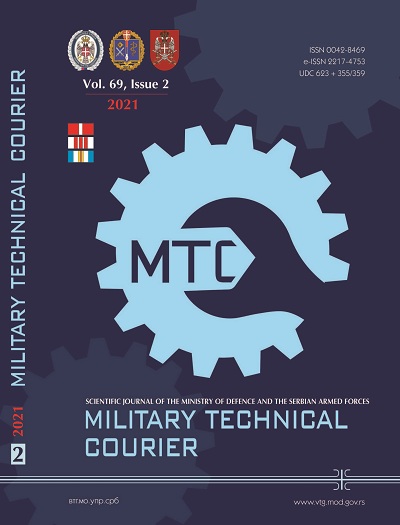Carbonation of minerals and slags under high pressure in an autoclave
Abstract
Introduction/purpose: Carbonation of minerals (olivine and wollastonite) and secondary materials such as slag under high pressure in autoclaves has high importance due to environmetal problems.
Methods: The most important for this process is to have a good knowledge of the behavior of carbon dioxide in water solution under high pressure, the precipitation of silica, dissolution of metals such as nickel and magnesium as well as subsequent filtration.
Results: The carbonation process of olivine und slag under high pressure (from 40 to 80 bar) in an autoclave was successfully performed at 175°C, with and without additivies.
Conclusion: A comparative analysis has confirmed better carbonation of slag (max. 300 kg/ton) in comparison to that of olivine (max. 70 kg/ton) under the same conditions.
References
Agrawal, A.К. & Mehra, A. 2020. Dunite carbonation in batch-tubular reactor. Environmental Science and Pollution Research, 27, pp.31439-31445. Available at: https://doi.org/10.1007/s11356-020-09426-4.
Chang, E-E., Pan, S-Y., Chen, Y-H., Tan, C-S. & Chiang, P-C. 2012. Accelerated carbonation of steelmaking slags in a high-gravity rotating packed bed. Journal of Hazardous Materials, 227-228, pp.97-106. Available at: https://doi.org/10.1016/j.jhazmat.2012.05.021.
Chang, E-E., Pan, S-Y., Chen, Y-H, Chu, H-W., Wang, C-F. & Chiang, P-C. 2011. CO2 sequestration by carbonation of steelmaking slags in an autoclave reactor. Journal of Hazardous Materials, 195, pp.107-114. Available at: https://doi.org/10.1016/j.jhazmat.2011.08.006.
Gadikota, G., Matter, J., Kelemen, P. & Park, A-h.A. 2014. Chemical and morphological changes during olivine carbonation for CO2 storage in the presence of NaCl and NaHCO3. Physical Chemistry Chemical Physics, 16(10), pp.4679-4693. Available at: https://doi.org/10.1039/C3CP54903H.
Matus, C., Stopic, S., Etzold, S., Kremer, D., Wotruba, H., Dertmann, C., Telle, R., Friedrich, B. & Knops, P. 2020. Mechanism of Nickel, Magnesium, and Iron Recovery from Olivine Bearing Ore during Leaching with Hydrochloric Acid Including a Carbonation Pre-Treatment. Metals, 10(6), art.number:811, pp.811-827. Available at: https://doi.org/10.3390/met10060811.
Rahmani, O., Junin, R., Tyrer, M. & Mohsin, R. 2014. Mineral carbonation of red gypsum for CO2 sequestration. Energy & Fuels, 28(9), art.number:708. Available at: https://doi.org/10.1021/ef501265z.
Santos, R.M., Knops, P.C.M., Rijnsburger, K.L. & Chiang, Y.W. 2016. CO2 energy reactor–integrated mineral carbonation: perspectives on lab-scale investigation and products valorization. Frontiers in Energy Research, 4(art.number:5), pp.1-6. Available at: https://doi.org/10.3389/fenrg.2016.00005.
Stockmann, G.J., Wolff-Boenisch, D., Bovet, N., Gisslason, S.R., Oelkers, E.H. 2014. The role of silicate surfaces on calcite precipitation kinetics. Geochimica et Cosmochimica Acta, 135, pp.231-250. Available at: https://doi.org/10.1016/j.gca.2014.03.015.
Stopic, S., Dertmann, C., Koiwa, I., Kremer, D., Wotruba, H., Etzold, S., Telle, R., Knops, P. & Friedrich, B. 2019. Synthesis of Nanosilica via Olivine Mineral Carbonation under High Pressure in an Autoclave. Metals, 9(6), art.number:708, pp.135-147. Available at: https://doi.org/10.3390/met9060708.
Stopic, S., Dertmann, C., Modolo, G., Kegler, P., Neumeier, S., Kremer, D., Wotruba, H., Etzold, S., Telle, R., Rosani, D., Knops, P. & Friedrich, B. 2018. Synthesis of Magnesium Carbonate via Carbonation under High Pressure in an Autoclave. Metals, 8(12), art.number:993, pp.193-207. Available at: https://doi.org/10.3390/met8120993.
Proposed Creative Commons Copyright Notices
Proposed Policy for Military Technical Courier (Journals That Offer Open Access)
Authors who publish with this journal agree to the following terms:
Authors retain copyright and grant the journal right of first publication with the work simultaneously licensed under a Creative Commons Attribution License that allows others to share the work with an acknowledgement of the work's authorship and initial publication in this journal.
- Authors are able to enter into separate, additional contractual arrangements for the non-exclusive distribution of the journal's published version of the work (e.g., post it to an institutional repository or publish it in a book), with an acknowledgement of its initial publication in this journal.
- Authors are permitted and encouraged to post their work online (e.g., in institutional repositories or on their website) prior to and during the submission process, as it can lead to productive exchanges, as well as earlier and greater citation of published work (See The Effect of Open Access).

